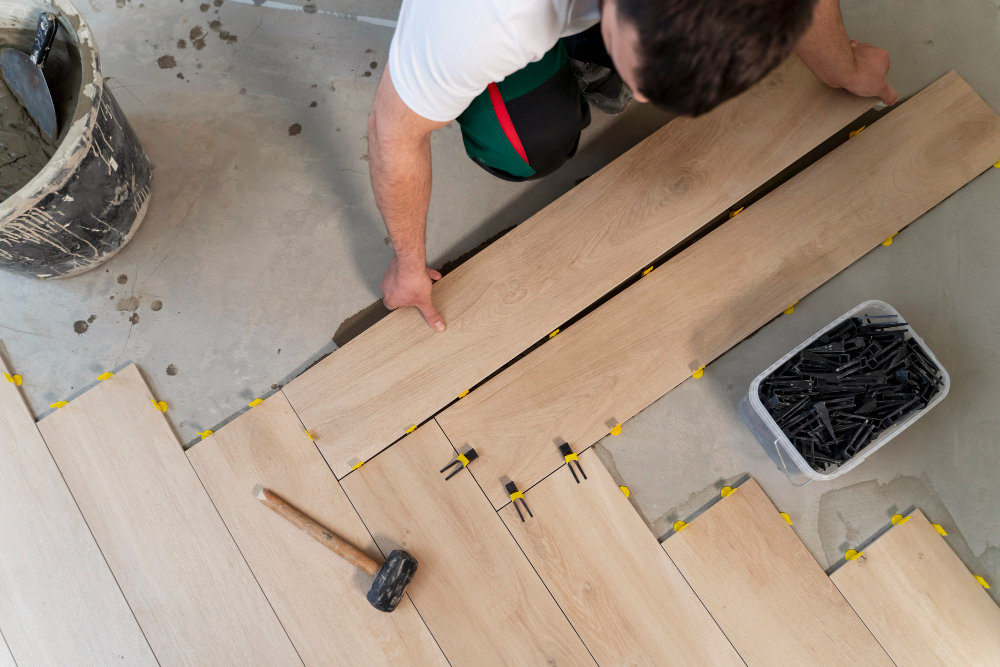INTERIOR
Wood Floors Refinishing




Commonly Asked Questions
The time it takes to refinish wood floors can vary quite a bit depending on several factors, but here’s a general overview:
– Preparation work – Removing furniture, baseboards, etc. can take 4-8 hours for an average sized room.
– Sanding – The actual sanding process typically takes 4-8 hours per 200-300 square feet of floor space. This involves using a drum sander and edger to remove the old finish.
– Staining and finishing – Applying the new stain and polyurethane finish usually takes 2-4 hours per coat, with 2-3 coats needed. So the staining/finishing can take 6-12 hours.
– Drying time – Each coat of polyurethane needs 24-48 hours to fully dry and cure before the next coat can be applied. The entire floor then needs 1-2 weeks to fully cure after the final coat.
So in total, for a typical 200-300 square foot room, the full wood floor refinishing process from start to finish can take 2-3 days of active work spread out over 1-2 weeks. Larger spaces will take proportionately longer. The time can also vary based on the complexity of the floor, accessibility, and any issues that arise during the sanding process.
Yes, wood floor refinishing can create a significant amount of dust. Here are some key points about the dust created during this process:
– Sanding is the main culprit – The drum sander and edging sander used to remove the old finish create large amounts of fine wood dust.
– Even with dust containment systems, some dust will escape into the room and surrounding areas. This is difficult to fully prevent.
– The more layers of old finish on the floor, the more sanding that is required, and the more dust will be generated.
– Hardwood floors tend to create more dust than softer wood floors like pine.
– The dust can settle on furniture, window sills, shelves, and other surfaces throughout the home.
– Proper containment, ventilation, and cleanup is critical to minimize the dust spread. This often involves sealing off the work area, using HEPA vacuums, and thorough cleaning.
– Some homeowners choose to vacate the home during the sanding and refinishing process to avoid dealing with the dust exposure.
So in summary, yes – wood floor refinishing is a very dusty process that requires significant cleanup efforts to mitigate the dust spread throughout the home. Proper preparation and containment is key to managing the dust.
No, not all wood floors can be refinished. There are a few key factors that determine whether a wood floor can be successfully refinished:
- Thickness of the wood – Wood floors need to have a certain minimum thickness of wear layer (usually at least 1/8 inch) in order to be sanded down and refinished multiple times over the floor’s lifetime. Thin, engineered wood floors may not have enough thickness to refinish.
- Condition of the existing finish – If the floor has extensive damage, deep scratches, or uneven wear, it may not be possible to sand it down evenly. At a certain point, the floor cannot be refinished and may need to be replaced.
- Type of wood – Softer woods like pine are more prone to denting and damage over time, making them more difficult to refinish successfully. Harder woods like oak, maple, and cherry tend to refinish better.
- Previous refinishing work – If a floor has been refinished many times already, there may not be enough wood thickness left to sand down again without exposing the subfloor.
So in general, the best candidates for refinishing are solid hardwood floors that are in relatively good shape, not too old, and haven’t been refinished numerous times already. Engineered and softer wood floors may not be viable for refinishing. As experienced flooring contractors, we can evaluate if a specific floor is suitable for refinishing.

Craftsmanship

Reliability

Integrity


